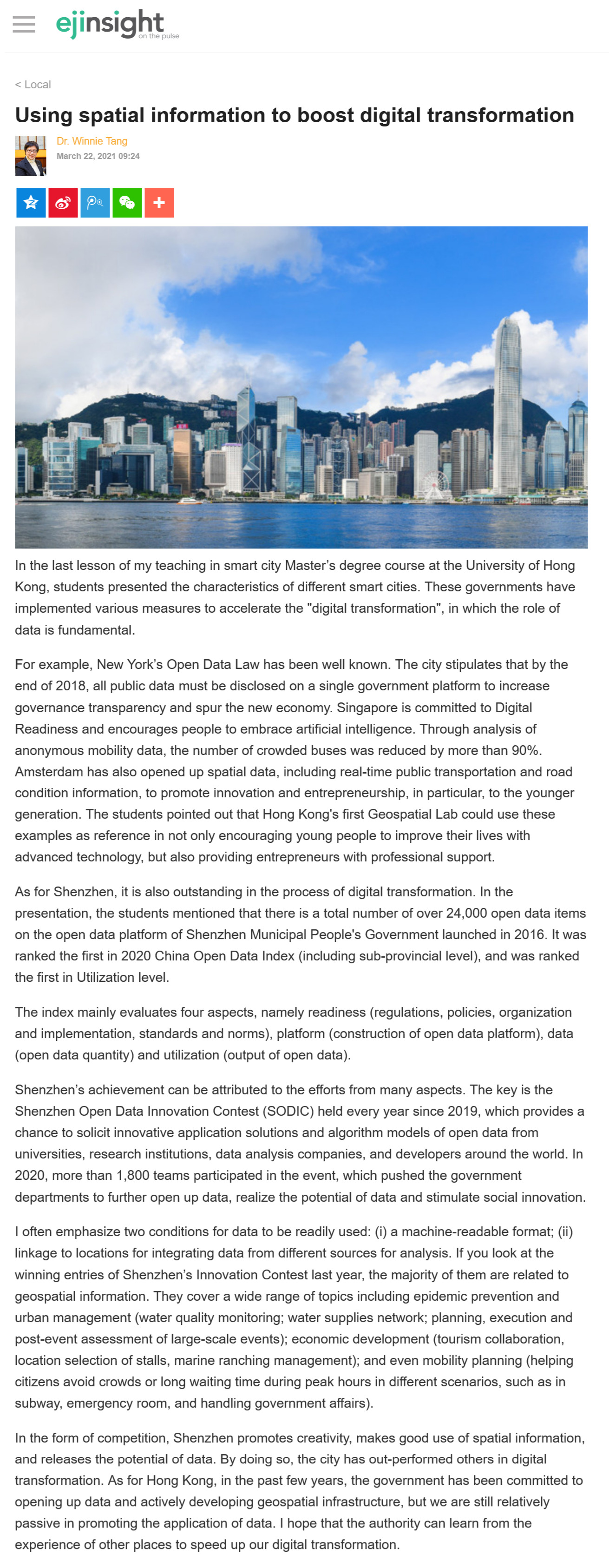網上版請按此

Using spatial information to boost digital transformation
In the last lesson of my teaching in smart city Master's degree course at the University of Hong Kong, students presented the characteristics of different smart cities. These governments have implemented various measures to accelerate the "digital transformation", in which the role of data is fundamental.
For example, New York's Open Data Law has been well known. The city stipulates that by the end of 2018, all public data must be disclosed on a single government platform to increase governance transparency and spur the new economy. Singapore is committed to Digital Readiness and encourages people to embrace artificial intelligence. Through analysis of anonymous mobility data, the number of crowded buses was reduced by more than 90%. Amsterdam has also opened up spatial data, including real-time public transportation and road condition information, to promote innovation and entrepreneurship, in particular, to the younger generation. The students pointed out that Hong Kong's first Geospatial Lab could use these examples as reference in not only encouraging young people to improve their lives with advanced technology, but also providing entrepreneurs with professional support.
As for Shenzhen, it is also outstanding in the process of digital transformation. In the presentation, the students mentioned that there is a total number of over 24,000 open data items on the open data platform of Shenzhen Municipal People's Government launched in 2016. It was ranked the first in 2020 China Open Data Index (including sub-provincial level), and was ranked the first in Utilization level.
The index mainly evaluates four aspects, namely readiness (regulations, policies, organization and implementation, standards and norms), platform (construction of open data platform), data (open data quantity) and utilization (output of open data).
Shenzhen's achievement can be attributed to the efforts from many aspects. The key is the Shenzhen Open Data Innovation Contest (SODIC) held every year since 2019, which provides a chance to solicit innovative application solutions and algorithm models of open data from universities, research institutions, data analysis companies, and developers around the world. In 2020, more than 1,800 teams participated in the event, which pushed the government departments to further open up data, realize the potential of data and stimulate social innovation.
I often emphasize two conditions for data to be readily used: (i) a machine-readable format; (ii) linkage to locations for integrating data from different sources for analysis. If you look at the winning entries of Shenzhen's Innovation Contest last year, the majority of them are related to geospatial information. They cover a wide range of topics including epidemic prevention and urban management (water quality monitoring; water supplies network; planning, execution and post-event assessment of large-scale events); economic development (tourism collaboration, location selection of stalls, marine ranching management); and even mobility planning (helping citizens avoid crowds or long waiting time during peak hours in different scenarios, such as in subway, emergency room, and handling government affairs).
In the form of competition, Shenzhen promotes creativity, makes good use of spatial information, and releases the potential of data. By doing so, the city has out-performed others in digital transformation. As for Hong Kong, in the past few years, the government has been committed to opening up data and actively developing geospatial infrastructure, but we are still relatively passive in promoting the application of data. I hope that the authority can learn from the experience of other places to speed up our digital transformation.
Dr. Winnie Tang
Adjunct Professor, Department of Computer Science, Faculty of Engineering; Department of Geography, Faculty of Social Sciences; and Faculty of Architecture, The University of Hong Kong